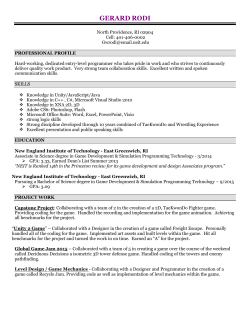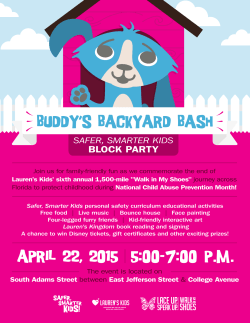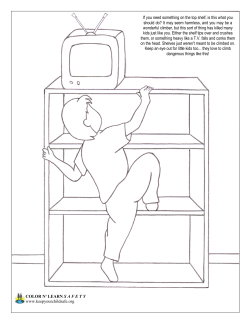
Why Coding is Your Child`s Key to Unlocking the
This copy is for your personal, non-commercial use only. To order presentation-ready copies for distribution to your colleagues, clients or customers visit http://www.djreprints.com. http://www.wsj.com/articles/why-coding-is-your-childs-key-to-unlocking-the-future-1430080118 TECH | KEYWORDS Why Coding Is Your Child’s Key to Unlocking the Future Educators call for making computer science a cornerstone of the curriculum, even for grade-school kids Ten-year-old Donovan Romero-Brathwaite, left, creator of the videogame ‘Gunman Taco Truck,’ works on coding a game with his father, John Romero. PHOTO: JAMES TENSUAN FOR THE WALL STREET JOURNAL By CHRISTOPHER MIMS April 26, 2015 4:28 p.m. ET Racing across the U.S. in your taco truck, you must fight off animals mutated by fallout from a nuclear war, and you must also turn them into delicious filling for the tacos you sell inside fortified towns. Your mission: Make it to the Canadian city of Winnipeg. You are “Gunman Taco Truck.” “It’s pretty much only a game that a kid would come up with,” says Brenda Romero, a videogame designer for more than 30 years and the mother of Donovan Romero-Brathwaite, the 10-year-old inventor of the game. And yet GTT already has been licensed by a videogame publisher for Mac, PC, iOS and Android, and may also arrive on consoles. It’s quite an outcome for something born of Saturday programming lessons with Donovan’s dad John, also a videogame designer of note. Donovan’s situation—access to two parents who are both programmers—is rare. In fact, in record numbers, children are picking up a skill their parents don’t possess: coding. And according to those responsible for teaching them, programming is just the beginning. What those kids are learning now—what they must learn, if they hope to be employable in the 21st century—is something educators call “procedural literacy.” “When you learn to code, you start thinking about processes in the world,” says Mitchell Resnick, the Massachusetts Institute of Technology professor heading up the effort to build the child-friendly programming language Scratch. Scratch has 6.2 million registered users and is accessible to children as young as five. Whether it’s understanding how complicated systems like economies work or tackling a problem in a stepwise fashion, coding is uniquely suited to training children not just how to solve problems, but also how to express themselves, says Mr. Resnick. “What’s fascinating about computer science is that it requires analytical skills, problem solving and creativity, while also being both foundational and vocational,” says Hadi Partovi, co-founder of Code.org, a nonprofit organization that promotes coding education. “I’m not sure there’s any other field that’s all those combined.” Not every child who learns to write will become a novelist, nor everyone who learns algebra a mathematician, yet we treat both as foundational skills that all children should learn. Coding is the same, say educators like Messrs. Partovi and Mr. Resnick, who are pushing for it to be available to every child in America. It doesn’t hurt their cause that the Bureau of Labor Statistics projects that there will be one million unfilled jobs for programmers in the U.S. by 2020. And that may be an underestimate, says Mr. Partovi. He adds that the more software and hardware humans create, the more jobs in software there are, as new platforms like smartphones and drones spawn their own software ecosystems. WSJ.D WSJ.D is the Journal’s home for tech news, analysis and product reviews. Startup Wants to Bring ‘Star Trek’ Like Health-Scan Tech Into the Home (http://www.wsj.com/articles /gadgets-bring-diagnostics-into-the-home-1430136181) Tech Giants Help Track Nepal Earthquake Survivors (http://www.wsj.com/articles/tech-giants-help-tracknepal-quake-survivors-as-communications-hit-1430119745) Applied Materials, Tokyo Electron Pull Plug on Merger Plan (http://www.wsj.com/articles/applied-materialstokyo-electron-scrap-merger-plan-1430117758) I’d go further than that: Understanding that in the future no profession is untouched by machines means admitting that coding is part of the liberal arts, and therefore a core skill every child must possess. After all the original definition of “liberal arts” meant the body of knowledge required to participate in civic life, and included what was then known of astronomy and mathematics. Educators who are taking professional training to learn how to incorporate coding into their lesson plans include not only teachers of math and technology, but also teachers of English, says Mr. Partovi. Coding is, in a way, just another form of writing, albeit one aimed at creating stories that are interactive and dynamic, says Mr. Resnick. Public schools remain slow to catch up. The majority, including Donovan’s school, don’t offer classes in coding. Mr. Partovi says that’s the biggest obstacle to progress. But for parents who aren’t waiting around, the options for teaching children how to code at home are growing. Bryson Payne, author of “Teach Your Kids to Code,” started with his own boys when one was two and the other four. He compares his approach to the Suzuki method of teaching young children violin, in which parents learn alongside their kids. Tablets are a natural vehicle for learning even for children who can’t yet read. The devices don’t require kids to first learn to use a mouse and keyboard, which can be tricky. Young kids easily absorb the lessons in programming games like “Lightbot,” says Gretchen LeGrande, head of Code in the Schools, a nonprofit group that targets girls and minorities. Everyone I interviewed observed that the best way to reach young children was to get them to create games, or to treat learning exercises as a form of play. Ms. LeGrande teaches kids concepts of binary code using nothing but a modified deck of cards, and the community of children registered with the Scratch language swap animations, code and stories in a gigantic online bazaar of imaginative play. Games based on popular children’s books are a staple. Codestudio, the online education program offered by Code.org, already reaches 1 in 10 grade-school students in the U.S., says Mr. Partovi. Of those students, 43% are female, and 47% are African-American or Hispanic. If even 1% of the middle schoolers enrolled in Codestudio eventually major in computer science, it would more than triple the number of women graduating in the field, says Mr. Partovi. Donovan, meanwhile, has no idea that he is the embodiment of an epochal shift in how his peers are educated. He is too busy learning level design, art direction and even retailing. That’s because “Gunman Taco Truck” already has a line of T-shirts. —Follow @mims on Twitter or christopher.mims@wsj.com Copyright 2014 Dow Jones & Company, Inc. All Rights Reserved This copy is for your personal, non-commercial use only. Distribution and use of this material are governed by our Subscriber Agreement and by copyright law. For non-personal use or to order multiple copies, please contact Dow Jones Reprints at 1-800-843-0008 or visit www.djreprints.com.
© Copyright 2025









